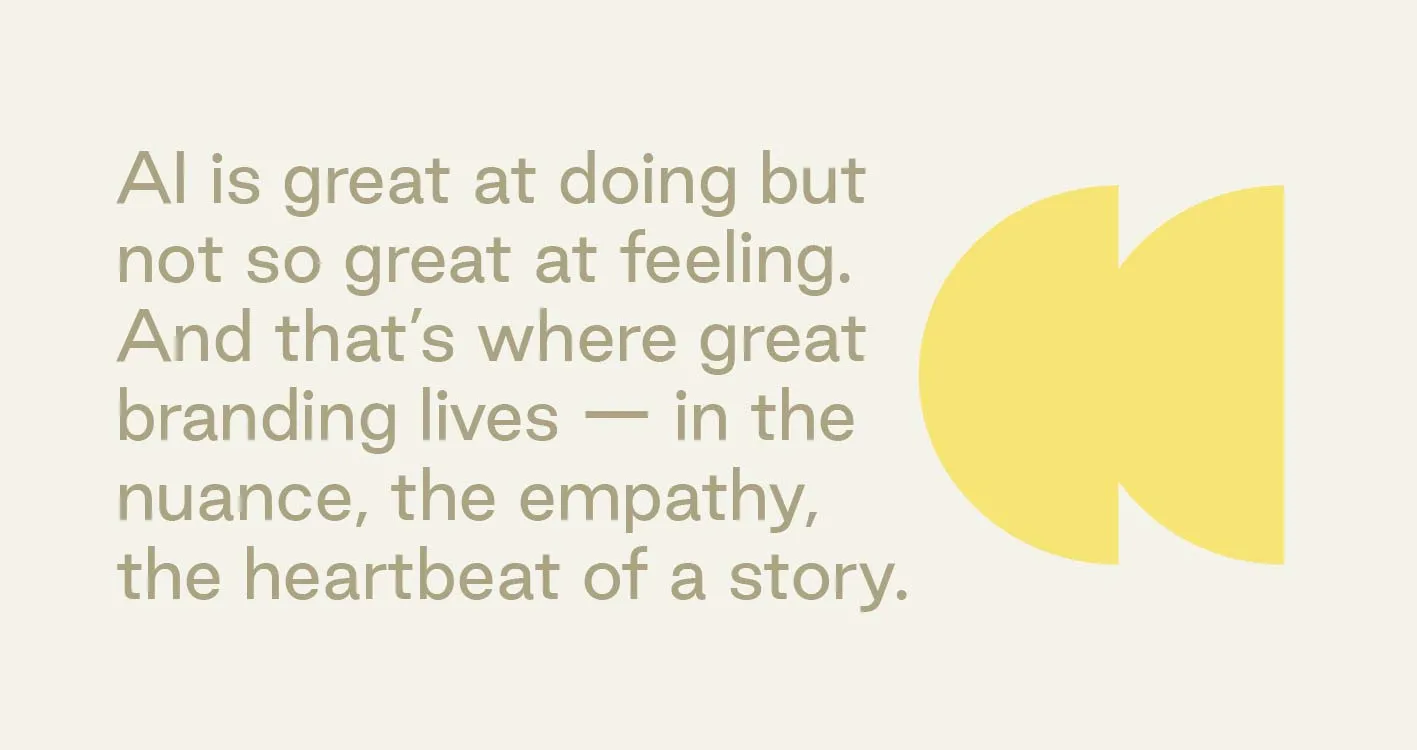AI is shaking up branding fast. It’s unleashed a wave of innovation, inspiration and let’s be honest, a few existential questions along the way.
Over the past year, AI-powered tools have stepped into the spotlight, promising to revolutionise how brands are built, presented and scaled. From creating strategies to designing logos, there’s a growing belief that AI can do what once took entire teams. And to be fair, it kind of can.
Today’s AI platforms can whip up mood boards, colour palettes, taglines and even consumer insights in a matter of minutes. They’re fast, affordable and accessible. For small businesses and startups, that’s a dream come true.
But here’s the catch: faster doesn’t always mean better. AI is great at doing but not so great at feeling. And that’s where great branding lives — in the nuance, the empathy, the heartbeat of a story.
Sure, AI can create a logo but not necessarily the one that truly captures your story, your values or the emotional connection you’re trying to build with your audience.
It can write your copy, but it doesn’t get why your voice needs a wink of humour, a spark of rebellion or a breath of calm.
AI-generated branding can often look polished on the surface yet it can lack soul. And that’s the risk.
When everyone’s using the same tools, the results start to blend: logos that look alike, messages that sound alike, brands that blur together.
In the race for efficiency, we risk losing the one thing that makes a brand unforgettable: its humanity.
But here’s the twist: AI isn’t the villain of this story. It’s the sidekick.
Used intentionally, AI can be a powerful creative partner, freeing humans to focus on what requires genuine insight — strategy, storytelling and emotional resonance.
According to the U.S. Chamber of Commerce
42% of small businesses are already using generative AI for tasks like image creation and chatbots*
Yet even with all that efficiency, one truth remains: AI can’t replicate the kind of deep, strategic thinking that comes from lived experience, intuition and a good old-fashioned human brainstorm.
For founders still shaping their brand’s identity or rediscovering their “why,” human connection still matters most.
AI won’t challenge you when your ideas aren’t quite ready.
AI won’t see the spark in your eyes when you talk about your mission.
And it definitely won’t tell you your big idea needs a little more heart and soul.
And then there is the big questions around originality and ownership.
AI doesn’t dream in blank slates. It uses data and patterns that borrow, blend and builds from what already exists. So when you ask it for a logo or tagline, chances are it is remixing bits and pieces from everywhere.
That raises some tough questions: Is it truly original? Is it truly yours? And what happens if someone else ends up with a brand or image that looks nearly identical?
Then comes the legal side. AI-generated content may not qualify for copyright protection which is a serious issue for brands when its their most valuable asset.
Brand vulnerability is growing at lightning speed. And in the age of AI, brand trust is becoming harder and more important to earn.
We’ve officially entered the “is it real?” era.
Consumers are questioning everything — the images they see, the links they click, even whether a brand is truly who it claims to be. Trust has become the new currency of branding. And right now, it’s in short supply.
Brands have to work harder than ever to earn and keep credibility. Consumers are savvier, employees are more vocal and misinformation spreads faster than a trending meme.
Brand transparency isn’t a nice-to-have anymore, it’s survival.
Engagement is another cornerstone of brand trust. Fast, genuine responses, whether on social, chat or email show that you actually value your audience’s time and attention.
And let’s be honest here: a beautifully rendered AI image of a golden retriever in a magical land holding your company’s birthday cake might look impressive and get a few likes but it won’t build real brand trust.
Younger audiences in particular are craving authenticity. They can spot a “too polished” visual from a mile away. It can give you that uneasy feeling when brands use AI-generated visuals to try and depict real people or products and rightfully so. AI has a place in creativity but when it comes to real life and products people want the real thing.
So, where do we go from here?
The brands leading the way aren’t choosing between AI or people, they’re learning how to use both. They let technology handle the grunt work so people can focus on what really matters: meaning, connection and story. AI brings speed, scale and structure. Humans bring originality, empathy and soul.
Great branding isn’t just a process, it’s a partnership and its about collaboration. It always has been.
And in a world where anything can be AI generated, being real will have the competitive edge.



